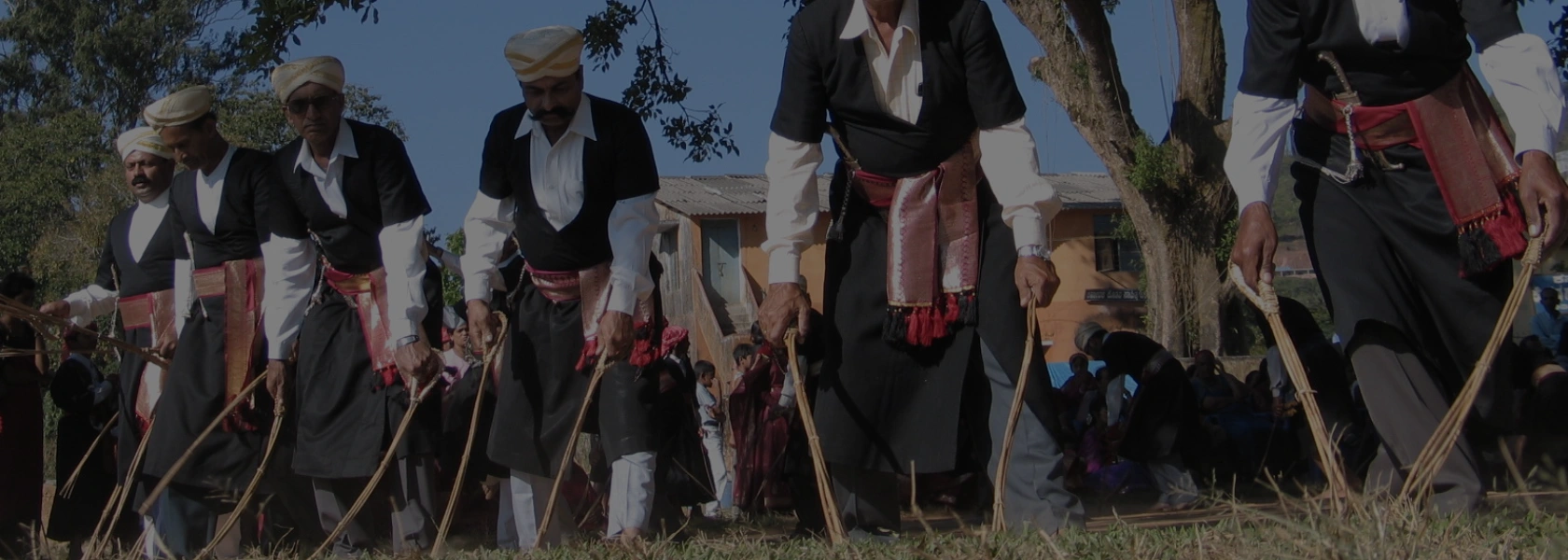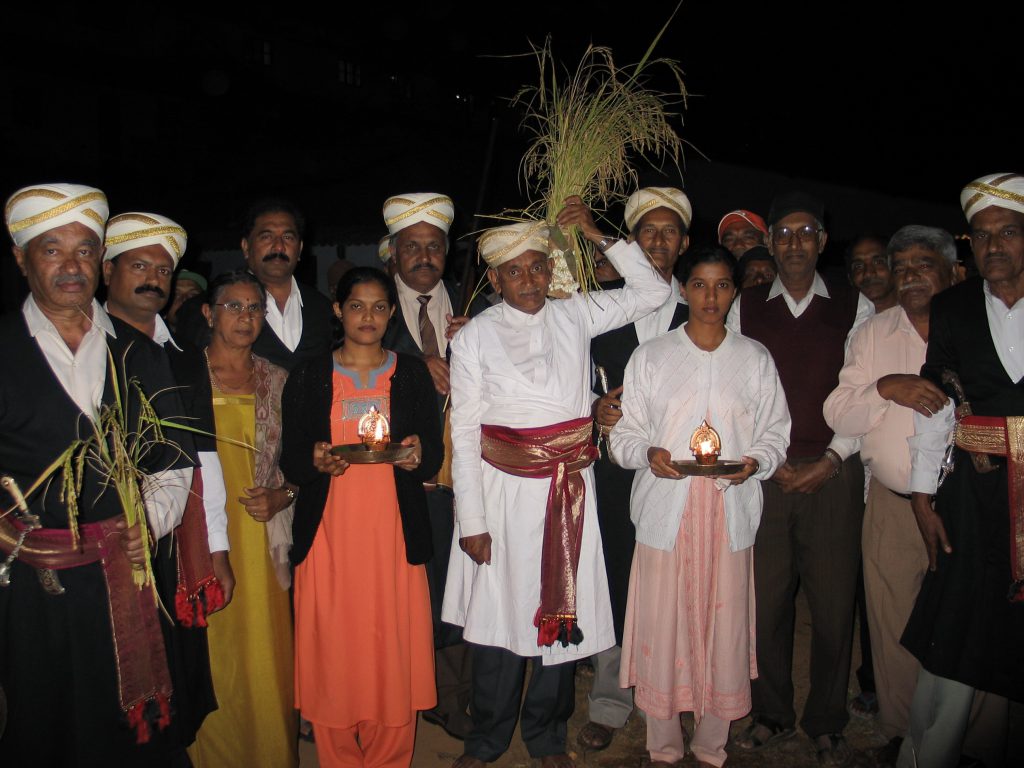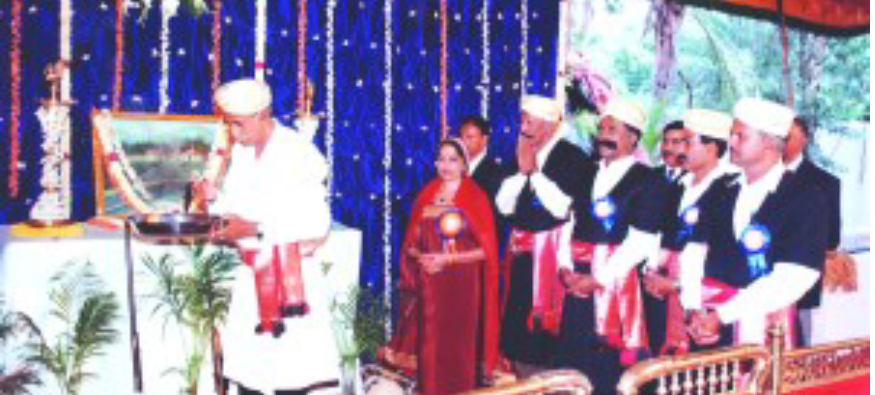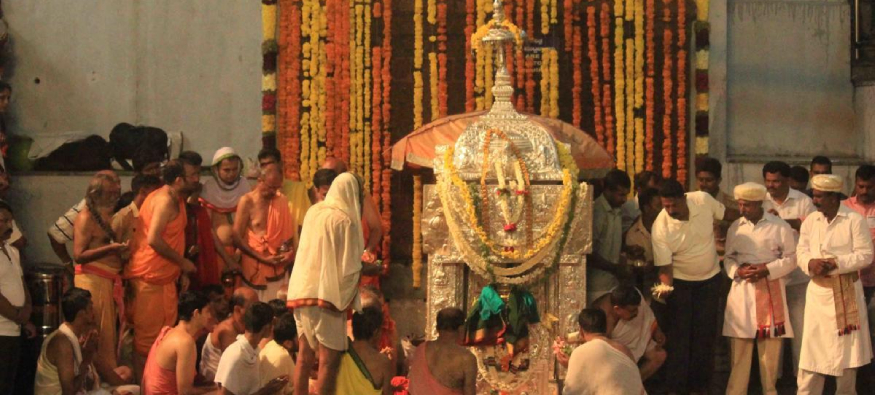
Festivals
PUTHARI FESTIVAL

Coorgs (Kodavas) have three major festivals. They are Keil Poldu, Huttari and Kaveri Shankaramana. Huttari, the annual rice harvest festival is perhaps the grandest of the three festivals and celebrated by most of the communities living in Coorg (Kodagu). Huttari is usually celebrated in late November or early December. It is celebrated on different days in different parts of the district, and usually falls on a full moon day .
The house and its surroundings are cleaned, buildings are whitewashed and doorways are decorated with a string of mango leaves and marigold on the festival day. After a bath, the person designated to cut the first paddy stalks dressed in white kupya( traditional Coorg dress for men) prepares the mat on the threshing floor, and supervises the preparation of the nere which is a collection of leaves from a particular tree which is rolled and tied together. The lady of the house fills the Huttari basket with paddy, some rice and rice flour. Close to it is a kutti(vessel made with hollow bamboo) with milk, honey, ghee, sesame seeds etc. A sickle is also placed with this. A mukkali (three legged stool) with the bolcha (lamp) and a plate with rice, betel leaves and areca is also kept. A basket with puffed rice and honey is also sent to the fields.
Women take a large dish full of rice and place a lighted lamp on it. This is carried by an unmarried girl, who goes ahead of the family members to the fields. The head of the family follows carrying a basket with honey and milk and the sickle. He pours the milk at the base of the paddy plant and all shout ‘Poli, Poli Deva!’ (Shower, Shower O God! Asking for a good harvest) The person with the kutti, ties the nere to the base of the paddy cluster. A single gun shot is fired in the air. The paddy sheaves are cut in odd numbers 5, 7, 9, 11 and placed in the kutti (basket). He also distributes it to those present. All return to the threshing area shouting Poli,Poli Deva . Stalks of rice are placed in the threshing area. At the entrance of the house they are welcomed by an unmarried girl who washes the feet of the kutti carrier and gives him some milk to drink. The man with the kutti, takes elders’ blessings by touching their feet. Elakki puttu (steamed rice preparation) with rice flour, sesame, ginger, coconut, bitter gourd skin, etc., is prepared. Bananas, milk, honey are added and little balls are made and placed on pipal leaves. The puttu is then served with other dishes like Thambutt (made with bananas, rice flour, coconut scraping, sesame seeds) and sweet rice payasa ( milk, sugar preparation with the new rice).
Meedi (food offering kept for one’s ancestors) is an important part of the celebration. All the cooked dishes are first kept for the ancestors. Bursting of firecrackers form an important part of the celebration.
There are many types of kol (stick) dances performed during Huttari. At the end of the dance is “Pariya Kali” (Dance of the Shields). Nowadays, sticks are used instead of shields. The dancers in pairs, strike each other below the knees. The spectators stop the dance if one member is stronger than the other. After three rounds they stop and embrace each other.
The festival brings together the village folk, and is a sort of thanksgiving for the bounty that has been received.
Article contributed by Chindamada Arati Monappa
THE KEIL MURTHA (Keil Podh) FESTIVAL

In earlier times, the headman of the village, together with people in his ‘nad ’, consulted with the astrologer, the auspicious day for the celebration of Kailpodh (the festival of arms). Today, it is celebrated, in the first week of September, mostly on September 3. It is similar to the Ayudha Puja (Worship of arms) that is celebrated in South India.
By the end of August, farmers have transplanted their paddy, and the first ears of paddy appear on the stalks in the fields. It is time to celebrate and prepare for the next season. Agricultural tools, are cleaned and put away, and weapons are brought out in preparation for the hunting season. On the morning of Kailpodh , family guns and other weapons like odikathis, pice kattis , are brought to a central room, cleaned and oiled. At the auspicious time given by the astrologer, incense is burned, and sandalwood paste is placed as a dot on each piece. A ‘tok puv’ (flower) is placed in the muzzle of each gun and ritual offering of the food cooked for the afternoon meal (usually kadambuttu, steamed broken rice cakes and pork curry with liquor) is placed on a banana leaf and placed near the weapons. Then it is time for the grand feast.
In the early evening, male members of the family assemble in front of the weapons. The eldest member reciting a verse, which calls for caution and faith in God, hands over the weapon to the next senior member, who takes his blessing by touching his feet, and he does the same, to younger male members of the family.
The men then go to the village mand (green) to take part in ‘coconut shooting’. The village head usually fires the first shot at the coconut tied high up on a tree. Earlier, this was a men’s preserve, today women also join in and many Coorg women are good shots. This practice of ‘coconut shooting’ is also a sport, at the Kodava Samaj meetings in most cities, allowing city dwellers to practice their shooting skills ! In the old days, there were running competitions, stone throwing, akin to shot put, and the cutting of banana stumps planted in a row, to test the efficiency of newly cleaned knives.
After the festival, at the time fixed by the astrologer, the village youth set out on a hunt. There are rules for dividing the game that is shot. The man who shoots an animal first, even if he doesn’t kill the animal, is given the head, thigh and shoulder meat – in addition to a share from the general pool. The person who touches the wounded animal first is also given some shoulder meat. Dogs taken on the hunt get their share too, even though it is given to the master, though bitches have no share!
Coorg festivals are celebrations of thanksgiving. As the compiler of ‘Pattole Palame’ folklore book mentions, Kailpodh is a ‘Muhurta’ for the paddy bearing stalk (Kail).
Article contributed by Chindamada Arati Monappa
KAVERI SANKRAMANA

Kaveri Sankramana (in October) celebrates the birth of the river Kaveri, whose waters nourish the land. The miraculous event of the water bubbling up and gushing forth at an auspicious time that day in the sacred Kundike, the small pond that is the source of the river in Talakaveri, is celebrated with much fervour. On the following day, goddess Kaveri is worshipped in every home in a simple ritual called Kani puje, where Kaveri is represented by a decorated coconut or cucumber. Kaveri is worshipped as water and not as an image.
As a community of nature worshippers, we think of ourselves as the offspring of the river because it originates from our land. It courses through our lives, from the time we are born until the day we die. Every landmark, every momentous occasion is marked by some association with the Kaveri.
At all our wedding ceremonies, a prayer is offered in the name of the river and the family’s ancestors. After the wedding, we go for a dip in the holy water.
The Kaveri figures not just in Kodava celebrations, but also in our grief. It is invoked in death. At the 11th-day ceremony after a person dies, the male family members shave their heads and go to the Talakaveri after visiting the Bhagamandala temple, for another dip in the river’s purifying waters. At home, the corpse is laid out in the house for people to pay their last respects, accompanied by a pot of Kaveri water. Then, tulsi leaves are dipped in the water and put on the dead person’s lips.
According to one legend, the sage Kavera Muni chose Brahmagiri in Coorg to meditate. He prayed to Brahma for children, who granted his prayers by giving him a daughter in the form of Lopamudra (also called Kaveri).
Lopamudra married sage Agastya on the condition that he wouldn’t stay away from her even for a moment. So one day, Agastya put his wife in his kamandala, a water pot, and went for a bath. Lopamudra got so angry at this that she spilled out of the pot and started to flow like a raging river. She washed over all the Kodava women, who pleaded with her to stop her from leaving their land. The story goes that she washed over them with such force, that their saris swept from front to back. Even now, Coorg women pleat their saris at the back, instead of the front.
To date, children in Coorg grow up listening to stories about the river, which marks its presence even in our traditional dress.
BISU CHANGRANDI ( Kodava New Year )
Bisu Changrandi (Visu Sankramana) is the start of the New Year for Kodavas. It is the first day of the month of Edamyar, around mid-April, and is the New Year’s day in Kerala and Tamil Nadu also.
On Bisu Changrandi day, kani puje (worship of mother earth) is performed in some parts of Kodagu. This is an auspicious day when farmers offer ritual prayers and start ploughing their paddy fields.
Source: Pattole Palame.
